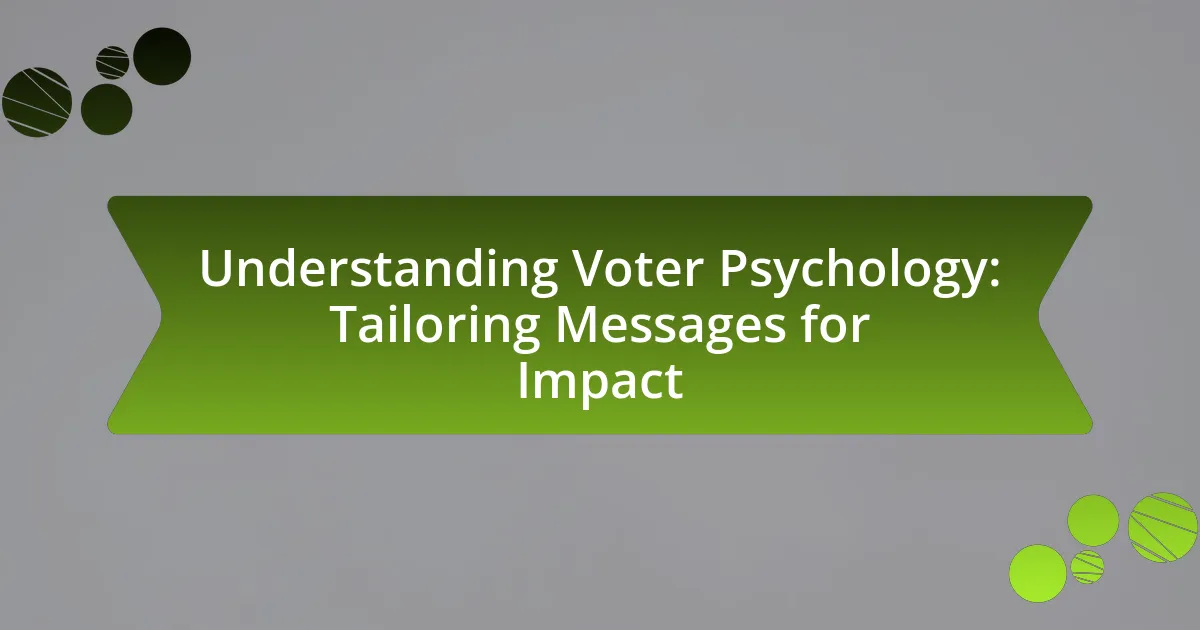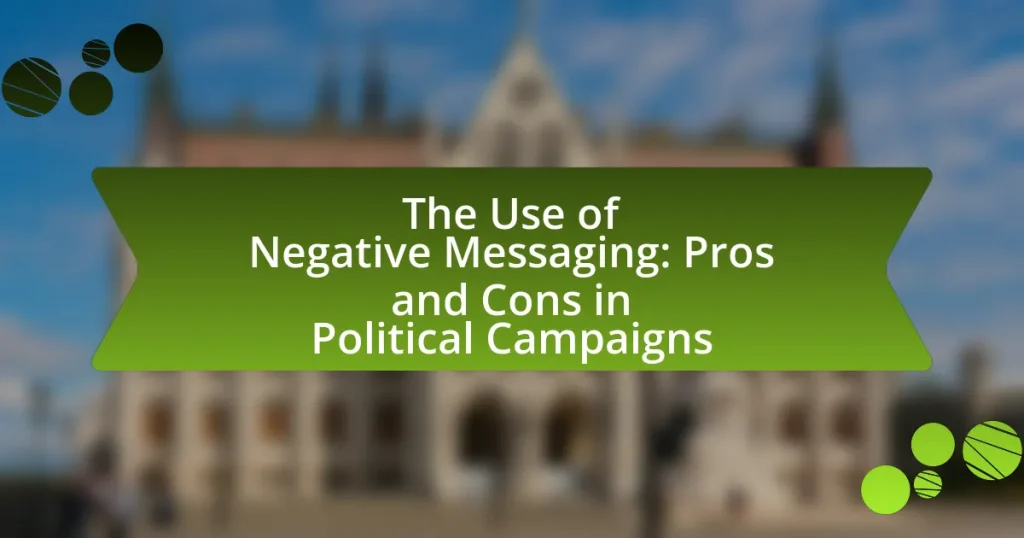Voter psychology is the examination of the cognitive, emotional, and social factors that influence voting behavior, including how beliefs and attitudes shape electoral decisions. This article explores the impact of voter psychology on electoral outcomes, emphasizing the significance of emotions, biases, and social identity in shaping voter preferences. Key factors such as audience segmentation, emotional appeals, and message framing are discussed as essential strategies for tailoring campaign messages to resonate with specific voter demographics. Additionally, the article highlights the importance of understanding cultural context and avoiding common pitfalls in messaging to enhance voter engagement and turnout.
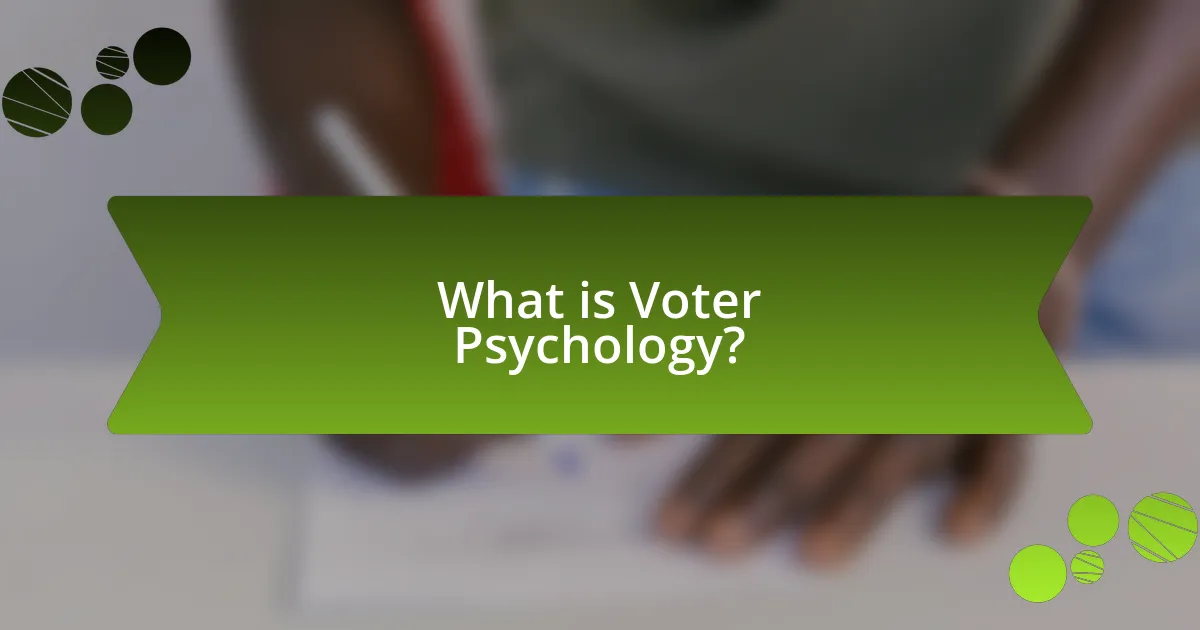
What is Voter Psychology?
Voter psychology is the study of the cognitive, emotional, and social factors that influence individuals’ voting behavior. This field examines how beliefs, attitudes, and perceptions about candidates, parties, and issues shape electoral decisions. Research indicates that factors such as group identity, personal values, and emotional responses significantly impact voter choices, as evidenced by studies showing that voters often rely on heuristics or mental shortcuts when making decisions in complex political environments.
How does Voter Psychology influence electoral outcomes?
Voter psychology significantly influences electoral outcomes by shaping how individuals perceive candidates and issues. Psychological factors such as emotions, biases, and social identity affect decision-making processes, leading voters to favor candidates who resonate with their beliefs and values. For instance, studies show that voters are more likely to support candidates who evoke positive emotions or align with their social group, as evidenced by research from the American Political Science Review, which highlights the impact of emotional appeals on voter behavior. Additionally, cognitive biases, such as confirmation bias, lead voters to seek information that supports their pre-existing views, further solidifying their choices. Thus, understanding voter psychology is crucial for tailoring campaign messages that effectively engage and persuade the electorate.
What are the key factors that shape Voter Psychology?
Key factors that shape voter psychology include social identity, political ideology, emotional responses, and information processing. Social identity influences how individuals perceive themselves in relation to political groups, affecting their voting behavior. Political ideology provides a framework for understanding political issues, guiding voters’ preferences and decisions. Emotional responses, such as fear or hope, can significantly impact voter turnout and candidate support, as evidenced by studies showing that emotionally charged messages are more persuasive. Information processing, including how voters interpret and evaluate political information, is crucial; research indicates that cognitive biases can lead to selective exposure to information that aligns with pre-existing beliefs. These factors collectively shape how voters engage with the political landscape and make electoral choices.
How do emotions play a role in Voter Psychology?
Emotions significantly influence voter psychology by shaping perceptions, attitudes, and decision-making processes. Emotional responses to political messages can enhance engagement and motivate individuals to participate in elections. For instance, research by Paul Slovic and colleagues highlights that voters often rely on emotional cues rather than rational analysis when evaluating candidates, leading to decisions driven by feelings such as fear, hope, or anger. This emotional engagement can be seen in campaign strategies that evoke strong feelings, which have been shown to increase voter turnout and support for candidates.
Why is understanding Voter Psychology important for campaigns?
Understanding voter psychology is crucial for campaigns because it enables candidates to tailor their messages effectively to resonate with the electorate. By grasping the motivations, beliefs, and emotions that drive voter behavior, campaigns can craft targeted strategies that address specific concerns and values of different demographic groups. Research indicates that campaigns that align their messaging with the psychological profiles of voters can increase engagement and influence decision-making, ultimately leading to higher voter turnout and support. For instance, a study by the Pew Research Center found that voters are more likely to respond positively to messages that reflect their personal experiences and social identities, highlighting the importance of psychological insights in campaign strategies.
How can campaigns leverage Voter Psychology to increase engagement?
Campaigns can leverage voter psychology to increase engagement by utilizing targeted messaging that resonates with the values and emotions of specific voter demographics. Research indicates that emotional appeals, such as fear or hope, can significantly influence voter behavior; for instance, a study published in the Journal of Politics found that emotionally charged messages can increase voter turnout by up to 20%. Additionally, campaigns can employ social proof, showcasing endorsements from community leaders or highlighting collective voter actions, which can enhance perceived legitimacy and motivate individuals to participate. By understanding cognitive biases, such as the bandwagon effect, campaigns can create narratives that encourage voters to align with perceived popular choices, further driving engagement.
What are the risks of ignoring Voter Psychology in messaging?
Ignoring voter psychology in messaging can lead to ineffective communication and decreased voter engagement. When messages do not resonate with the emotional and cognitive frameworks of voters, they may fail to capture attention or inspire action. Research indicates that voters are influenced by their beliefs, emotions, and social identities; thus, messages that overlook these psychological factors can result in misinterpretation or apathy. For instance, a study by the Pew Research Center found that emotionally charged messages significantly increase voter turnout compared to neutral messages. Therefore, neglecting voter psychology risks alienating potential supporters and undermining campaign effectiveness.
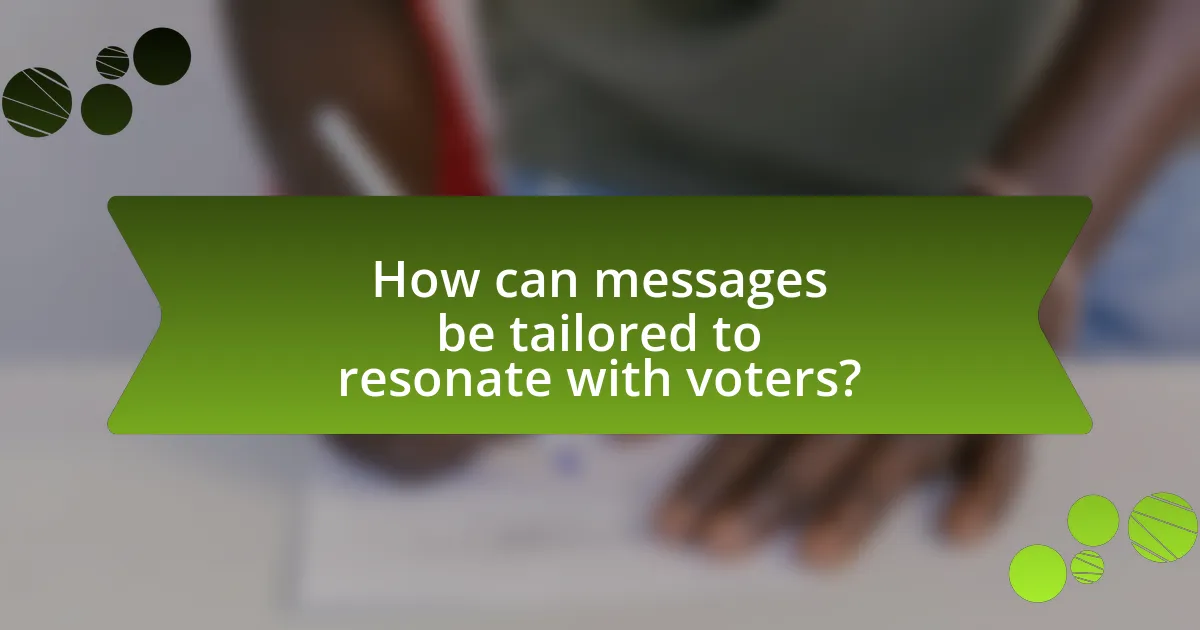
How can messages be tailored to resonate with voters?
Messages can be tailored to resonate with voters by aligning them with the values, beliefs, and concerns of the target audience. Research indicates that voters are more likely to engage with messages that reflect their personal experiences and address their specific needs. For instance, a study by the Pew Research Center found that 70% of voters prioritize candidates who understand their community’s issues. By utilizing data analytics to segment voter demographics and employing targeted communication strategies, campaigns can craft messages that speak directly to the interests of different voter groups, enhancing relatability and emotional connection.
What strategies can be used to tailor messages effectively?
To tailor messages effectively, one can employ strategies such as audience segmentation, emotional appeal, and message framing. Audience segmentation involves categorizing voters based on demographics, interests, and behaviors, allowing for targeted communication that resonates with specific groups. Emotional appeal leverages feelings to connect with voters, as studies show that emotionally charged messages can significantly influence decision-making. Message framing focuses on presenting information in a way that highlights certain aspects while downplaying others, which can shape perceptions and attitudes. For instance, research by the Pew Research Center indicates that framing issues in terms of personal impact can enhance voter engagement and response.
How does demographic targeting enhance message tailoring?
Demographic targeting enhances message tailoring by allowing communicators to customize their messages based on specific characteristics such as age, gender, income, and education level. This targeted approach increases the relevance of the message to the audience, leading to higher engagement and effectiveness. For instance, research indicates that messages tailored to the interests and values of specific demographic groups can significantly improve response rates; a study by the Pew Research Center found that targeted political messages can increase voter turnout by as much as 20%. By aligning the content and delivery of messages with the preferences of distinct demographic segments, communicators can foster a stronger connection and drive desired actions.
What role does cultural context play in message tailoring?
Cultural context plays a crucial role in message tailoring by influencing how messages are perceived and understood by different audiences. Tailoring messages to align with cultural values, beliefs, and norms enhances their relevance and effectiveness. For instance, research indicates that messages that resonate with cultural identity can significantly increase engagement and persuasion among target groups. A study by Hofstede (1980) highlights that cultural dimensions, such as individualism versus collectivism, affect communication styles and preferences, thereby impacting how messages should be crafted for different cultural contexts.
Why is message framing crucial in voter communication?
Message framing is crucial in voter communication because it influences how voters perceive issues and candidates, ultimately affecting their decisions. Effective message framing can highlight specific aspects of a policy or candidate that resonate with voters’ values and emotions, thereby increasing engagement and support. Research indicates that voters are more likely to respond positively to messages that align with their pre-existing beliefs and attitudes, as demonstrated in studies like “The Role of Framing in Political Communication” by Druckman (2001), which shows that different frames can lead to significantly different public opinions on the same issue. Thus, strategic framing is essential for mobilizing voter support and shaping electoral outcomes.
What are the different types of message framing?
The different types of message framing include gain framing, loss framing, and attribute framing. Gain framing emphasizes the benefits of a particular choice or action, while loss framing highlights the potential negative outcomes of not taking that action. Attribute framing focuses on specific characteristics or features of an issue, influencing perceptions based on how the information is presented. Research by Tversky and Kahneman (1981) demonstrates that individuals are more likely to choose options presented with gain framing due to a preference for positive outcomes, while loss framing can evoke stronger emotional responses, impacting decision-making processes.
How does framing affect voter perception and decision-making?
Framing significantly influences voter perception and decision-making by shaping how information is presented and interpreted. When political issues are framed in a particular way, it can lead voters to prioritize certain aspects over others, affecting their opinions and choices. For instance, research by Kahneman and Tversky in 1981 demonstrated that individuals are more likely to support a policy when it is framed in terms of potential gains rather than losses, illustrating the impact of positive versus negative framing on decision-making. This framing effect can alter the perceived importance of issues, sway public opinion, and ultimately influence electoral outcomes.
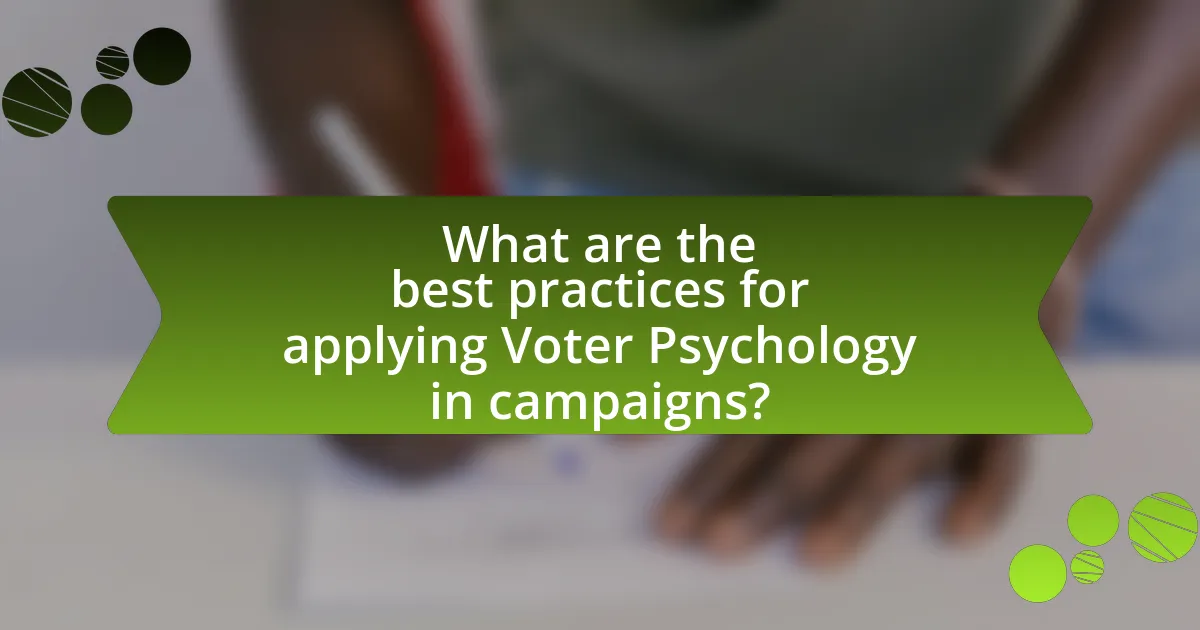
What are the best practices for applying Voter Psychology in campaigns?
The best practices for applying voter psychology in campaigns include understanding voter motivations, utilizing emotional appeals, and segmenting the audience for targeted messaging. Understanding voter motivations involves researching what drives voters’ decisions, such as economic concerns or social issues, which can guide campaign strategies. Emotional appeals, such as storytelling and relatable narratives, can create a connection with voters, making messages more impactful. Segmenting the audience allows campaigns to tailor messages to specific demographics, increasing relevance and engagement. Research indicates that campaigns that effectively leverage these practices can significantly enhance voter turnout and support, as evidenced by studies showing that emotionally resonant messages can increase voter engagement by up to 20%.
How can campaigns measure the effectiveness of their messages?
Campaigns can measure the effectiveness of their messages through various methods such as surveys, focus groups, and data analytics. Surveys can quantify voter responses to specific messages, allowing campaigns to assess changes in opinion or behavior. Focus groups provide qualitative insights into voter perceptions and emotional reactions to messages. Data analytics, including tracking engagement metrics on social media and website interactions, offers concrete evidence of message reach and resonance. For instance, a study by the Pew Research Center found that campaigns utilizing data analytics saw a 20% increase in voter engagement compared to those that did not. These methods collectively enable campaigns to refine their messaging strategies based on direct feedback and measurable outcomes.
What tools and methods are available for measuring voter response?
Surveys and polls are primary tools for measuring voter response, providing quantitative data on voter preferences and opinions. These methods include telephone surveys, online questionnaires, and in-person interviews, which can capture a wide range of demographic information and attitudes. For instance, the American National Election Studies (ANES) utilizes extensive surveys to analyze voter behavior and preferences, demonstrating the effectiveness of this method in understanding electoral dynamics. Additionally, focus groups offer qualitative insights by facilitating discussions among selected voters, allowing researchers to explore deeper motivations and sentiments behind voter choices. These combined approaches enable a comprehensive understanding of voter response, essential for tailoring political messages effectively.
How can feedback be used to refine messaging strategies?
Feedback can be used to refine messaging strategies by providing insights into audience perceptions and preferences. Analyzing feedback allows organizations to identify which messages resonate most effectively with voters, enabling adjustments to tone, content, and delivery methods. For instance, surveys and focus groups can reveal specific language or themes that engage voters, while social media analytics can track engagement metrics, indicating which messages prompt action or discussion. This data-driven approach ensures that messaging evolves in alignment with voter sentiment, ultimately enhancing the effectiveness of communication efforts.
What common pitfalls should campaigns avoid when tailoring messages?
Campaigns should avoid the pitfalls of oversimplification, lack of audience segmentation, and ignoring cultural context when tailoring messages. Oversimplification can lead to messages that fail to resonate with the complexity of voter concerns, resulting in disengagement. Lack of audience segmentation means campaigns may deliver generic messages that do not address the specific needs and preferences of different voter groups, diminishing the effectiveness of communication. Ignoring cultural context can alienate potential supporters by failing to acknowledge the diverse backgrounds and values within the electorate, which can lead to misinterpretation or offense. These pitfalls can significantly undermine a campaign’s ability to connect with voters and achieve desired outcomes.
How can overgeneralization harm voter engagement?
Overgeneralization can harm voter engagement by creating a disconnect between political messages and the diverse needs of the electorate. When campaigns use broad statements that fail to acknowledge the complexities of individual voter experiences, they risk alienating specific groups. For instance, research by the Pew Research Center indicates that voters often feel misunderstood when their unique concerns are overlooked, leading to decreased motivation to participate in elections. This lack of tailored communication can result in lower voter turnout and diminished trust in political institutions, as individuals may perceive that their voices are not valued or represented.
What are the consequences of misinterpreting voter psychology?
Misinterpreting voter psychology can lead to ineffective campaign strategies, resulting in decreased voter engagement and support. When political campaigns fail to accurately understand the motivations and concerns of their target audience, they risk alienating potential voters. For instance, a study by the Pew Research Center found that campaigns that do not resonate with the values and beliefs of voters often see a significant drop in turnout, as voters feel disconnected from the candidates’ messages. Additionally, misinterpretation can lead to the allocation of resources toward messaging that does not address key issues, ultimately diminishing the overall effectiveness of the campaign.
What practical tips can enhance message impact based on Voter Psychology?
To enhance message impact based on voter psychology, utilize emotional appeals, clear messaging, and social proof. Emotional appeals resonate with voters, as studies show that emotions significantly influence decision-making; for instance, a 2016 study published in the Journal of Politics found that emotionally charged messages can increase voter engagement and turnout. Clear messaging ensures that voters easily understand the core message, which is crucial since cognitive overload can lead to disengagement. Additionally, incorporating social proof, such as testimonials or endorsements from trusted figures, can enhance credibility and influence voter perceptions, as demonstrated by research from the American Political Science Review, which indicates that voters are more likely to align with candidates endorsed by individuals they respect.
